Influence of Austenite Grain Size on the Variant Configurations of Martensite in a Fe-30.5Ni-0.155C Alloy
Abstract
:1. Introduction
1.1. Variant Pairings in Steel Martensite
1.2. Effect of Grain Size on Ms, Martensite Morphology, and Its Kinetics
1.3. Aims of the Present Study
2. Materials and Methods
3. Results
3.1. The Crystallography of Plate Groups
3.2. The Hierarchical Configurations of Variants in CG Sample
3.2.1. Crystallographic Analysis
3.2.2. Mechanical Couplings between Variants
3.3. Self-Accommodating Configurations of Variants in FG Sample
4. Discussion
5. Conclusions
Supplementary Materials
Author Contributions
Funding
Data Availability Statement
Acknowledgments
Conflicts of Interest
References
- Kinney, C.C.; Pytlewski, K.R.; Khachaturyan, A.G.; Morris, J.W. The Microstructure of Lath Martensite in Quenched 9Ni Steel. Acta Mater. 2014, 69, 372–385. [Google Scholar] [CrossRef]
- Morito, S.; Huang, X.; Furuhara, T.; Maki, T.; Hansen, N. The Morphology and Crystallography of Lath Martensite in Alloy Steels. Acta Mater. 2006, 54, 5323–5331. [Google Scholar] [CrossRef]
- Morito, S.; Tanaka, H.; Konishi, R.; Furuhara, T.; Maki, T. The Morphology and Crystallography of Lath Martensite in Fe-C Alloys. Acta Mater. 2003, 51, 1789–1799. [Google Scholar] [CrossRef]
- Brust, A.F.; Niezgoda, S.R.; Yardley, V.A.; Payton, E.J. Analysis of Misorientation Relationships Between Austenite Parents and Twins. Metall. Mater. Trans. A 2019, 50, 837–855. [Google Scholar] [CrossRef]
- Cayron, C. EBSD Imaging of Orientation Relationships and Variant Groupings in Different Martensitic Alloys and Widmanstätten Iron Meteorites. Mater. Charact. 2014, 94, 93–110. [Google Scholar] [CrossRef]
- Stormvinter, A.; Miyamoto, G.; Furuhara, T.; Hedström, P.; Borgenstam, A. Effect of Carbon Content on Variant Pairing of Martensite in Fe–C Alloys. Acta Mater. 2012, 60, 7265–7274. [Google Scholar] [CrossRef]
- Qi, L.; Khachaturyan, A.G.; Morris, J.W. The Microstructure of Dislocated Martensitic Steel: Theory. Acta Mater. 2014, 76, 23–39. [Google Scholar] [CrossRef]
- Sherby, O.D.; Wadsworth, J.; Lesuer, D.R.; Syn, C.K. Revisiting the Structure of Martensite in Iron-Carbon Steels. Mater. Trans. 2008, 49, 2016–2027. [Google Scholar] [CrossRef]
- Bokros, J.C.; Parker, E.R. The Mechanism of the Martensite Burst Transformation in FeNi Single Crystals. Acta Metall. 1963, 11, 1291–1301. [Google Scholar] [CrossRef]
- Shinohara, Y.; Akabane, S.; Inamura, T. Analysis of Variant-Pairing Tendencies in Lenticular Martensite Microstructures Based on Rank-1 Connection. Sci. Rep. 2021, 11, 14957. [Google Scholar] [CrossRef]
- Okamoto, H.; Oka, M.; Tamura, I. Couplings of Thin-Plate Martensites in an Fe–Ni–C Alloy. Trans. Jpn. Inst. Met. 1978, 19, 674–684. [Google Scholar] [CrossRef]
- Shinohara, Y.; Hishida, M.; Tanaka, Y.; Inamura, T. Analysis of Thin-Plate Martensite Microstructure in Steel Focusing on Incompatibility and Its Visualization. Acta Mater. 2023, 259, 119275. [Google Scholar] [CrossRef]
- Hayzelden, C.; Cantor, B. The Martensite Transformation in Fe−Ni−C Alloys. Acta Metall. 1986, 34, 233–242. [Google Scholar] [CrossRef]
- Guimarães, J.R.C.; Rios, P.R. Martensite Start Temperature and the Austenite Grain-Size. J. Mater. Sci. 2010, 45, 1074–1077. [Google Scholar] [CrossRef]
- Rios, P.R.; Guimarães, J.R.C. Microstructural Path Analysis of Athermal Martensite. Scr. Mater. 2007, 57, 1105–1108. [Google Scholar] [CrossRef]
- Umemoto, M.; Owen, W.S. Effects of Austenitizing Temperature and Austenite Grain Size on the Formation of Athermal Martensite in an Iron-Nickel and an Iron-Nickel-Carbon Alloy. Metall. Trans. 1974, 5, 2041–2046. [Google Scholar] [CrossRef]
- Entwisle, A.R. The Kinetics of Martensite Formation in Steel. Met. Trans. 1971, 2, 2395–2407. [Google Scholar] [CrossRef]
- Skrotzki, B. Fractal Analysis of Martensite in an Fe-Ni Alloy. J. Mater. Sci. 1991, 26, 1073–1077. [Google Scholar] [CrossRef]
- Malet, L. The Formation of Plate Martensite in a Fe-High Ni Alloy: Crystallography and Variant Selection. Ph.D. Thesis, Université Libre de Bruxelles, Bruxelles, Belgium, 2015. [Google Scholar]
- Maki, T.; Shimooka, S.; Fujiwara, S.; Tamura, I. Formation Temperature and Growth Behavior of Thin Plate Martensite in Fe–Ni–C Alloys. Trans. Jpn. Inst. Metall. 1975, 16, 35–41. [Google Scholar] [CrossRef]
- Gu, X.-F.; Furuhara, T.; Zhang, W.-Z. IUCr PTCLab : Free and Open-Source Software for Calculating Phase Transformation Crystallography. J. Appl. Crystallogr. 2016, 49, 1099–1106. [Google Scholar] [CrossRef]
- Bate, P.; Hutchinson, B. The Effect of Elastic Interactions between Displacive Transformations on Textures in Steels. Acta Mater. 2000, 48, 3183–3192. [Google Scholar] [CrossRef]
- Bhattacharya, K. Self-Accommodation in Martensite. Arch. Ration. Mech. Anal. 1992, 120, 201–244. [Google Scholar] [CrossRef]
- Bhattacharya, K. Microstructure of Martensite: Why It Forms and How It Gives Rise to the Shape-Memory Effect; Oxford Series on Materials Modelling; Oxford University Press: Oxford, UK; New York, NY, USA, 2003; ISBN 978-0-19-850934-9. [Google Scholar]
- Balandraud, X.; Delpueyo, D.; Grédiac, M.; Zanzotto, G. Almost Compatible Microstructures in Shape Memory Alloys. Acta Mater. 2010, 58, 4559–4577. [Google Scholar] [CrossRef]
- Saburi, T.; Wayman, C.M. Crystallographic Similarities in Shape Memory Martensites. Acta Metall. 1979, 27, 979–995. [Google Scholar] [CrossRef]
- Nishida, M.; Hara, T.; Matsuda, M.; Ii, S. Crystallography and Morphology of Various Interfaces in Ti–Ni, Ti–Pd and Ni–Mn–Ga Shape Memory Alloys. Mater. Sci. Eng. A 2008, 481–482, 18–27. [Google Scholar] [CrossRef]
- Guimarães, J.R.C. Excess Driving Force to Initiate Martensite Transformation in Fine-Grained Austenite. Scripta Materialia 2007, 57, 237–239. [Google Scholar] [CrossRef]
- Umemoto, M.; Yoshitake, E.; Tamura, I. The Morphology of Martensite in Fe-C, Fe-Ni-C and Fe-Cr-C Alloys. J. Mater. Sci. 1983, 18, 2893–2904. [Google Scholar] [CrossRef]
- Jana, S.; Wayman, C.M. Crystallography of the {225}F Martensite Transformation in an Fe−Mn−Cr−C Alloy. Metall. Trans. 1970, 1, 2815–2823. [Google Scholar] [CrossRef]
- Patterson, R.L.; Wayman, G.M. The Crystallography and Growth of Partially-Twinned Martensite Plates in Fe-Ni Alloys. Acta Metall. 1966, 14, 347–369. [Google Scholar] [CrossRef]
- Bertrand, E.; Castany, P.; Yang, Y.; Menou, E.; Gloriant, T. Deformation Twinning in the Full-A″ Martensitic Ti-25Ta-20Nb Shape Memory Alloy. Acta Mater. 2016, 105, 94–103. [Google Scholar] [CrossRef]
- Kaletina, Y.V.; Schastlivtsev, V.M.; Fokina, E.A. Effect of Magnetic Field on Martensitic Transformation in Iron-Nickel Alloys with Different Size of Austenite Grains. Met. Sci. Heat. Treat. 2008, 50, 164–170. [Google Scholar] [CrossRef]
- Yang, H.; Yan, W.; Deng, X.; Zhang, M.; Wang, Y. Improving the Shape Memory Effect of a Fe-Mn-Si-Cr-Ni Alloy through Shot Peening. Materials 2022, 15, 2585. [Google Scholar] [CrossRef] [PubMed]
- Kajiwara, S.; Kikuchi, T. Shape Memory Effect and Related Transformation Behavior in Fe−Ni−C Alloys. Acta Metall. Et Mater. 1990, 38, 847–855. [Google Scholar] [CrossRef]
- Kajiwara, S. Characteristic Features of Shape Memory Effect and Related Transformation Behavior in Fe-Based Alloys. Mater. Sci. Eng. A 1999, 273–275, 67–88. [Google Scholar] [CrossRef]
- Maki, T.; Kobayashi, K.; Minato, M.; Tamura, I. Thermoelastic Martensite in an Ausaged FeNiTiCo Alloy. Scr. Metall. 1984, 18, 1105–1109. [Google Scholar] [CrossRef]
- Tanaka, Y.; Himuro, Y.; Kainuma, R.; Sutou, Y.; Omori, T.; Ishida, K. Ferrous Polycrystalline Shape-Memory Alloy Showing Huge Superelasticity. Science 2010, 327, 1488–1490. [Google Scholar] [CrossRef] [PubMed]
- Kajiwara, S.; Kikuchi, T. On the Abnormally Large Tetragonality of Martensite in Fe−Ni−C Alloys. Acta Metall. Et Mater. 1991, 39, 1123–1131. [Google Scholar] [CrossRef]
- Dumas, O.; Malet, L.; Hary, B.; Prima, F.; Godet, S. Crystallography and Reorientation Mechanism upon Deformation in the Martensite of an α-α’ Ti-6Al-4V Dual-Phase Microstructure Exhibiting High Work-Hardening Rate. Acta Mater. 2021, 205, 116530. [Google Scholar] [CrossRef]
- Liu, Y.; Xie, Z.L.; Van Humbeeck, J.; Delaey, L. Effect of Texture Orientation on the Martensite Deformation of NiTi Shape Memory Alloy Sheet. Acta Mater. 1999, 47, 645–660. [Google Scholar] [CrossRef]

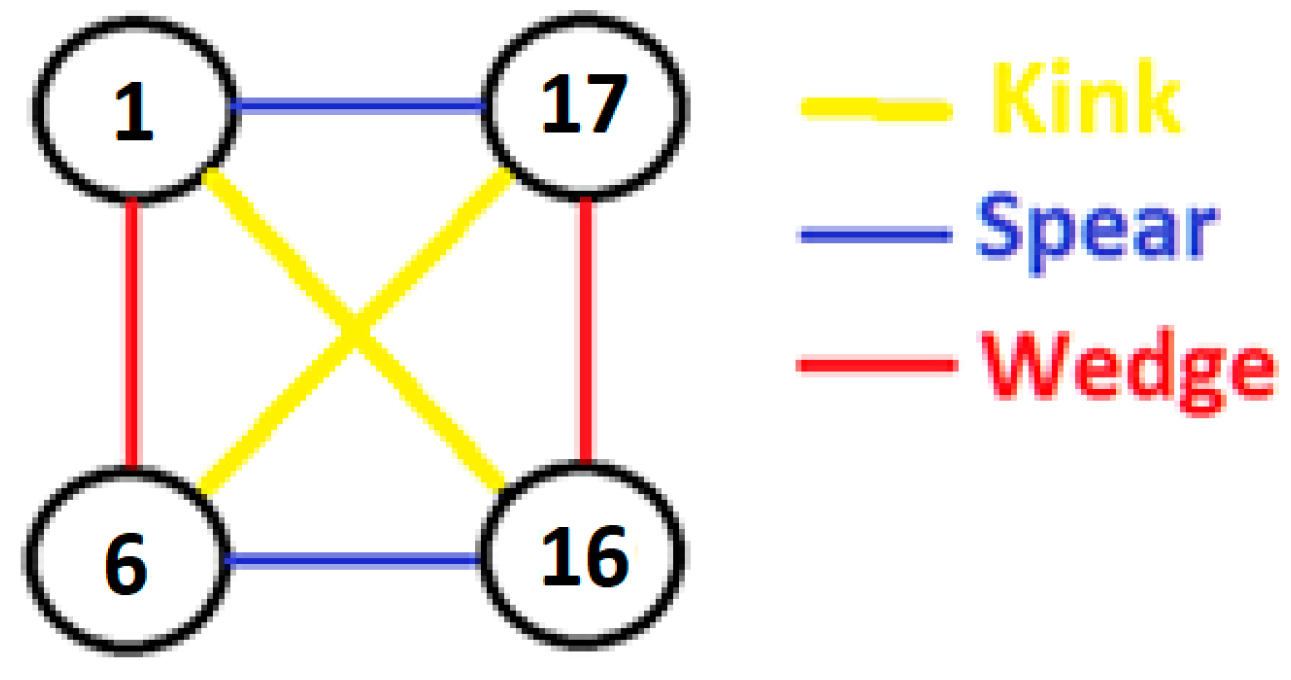
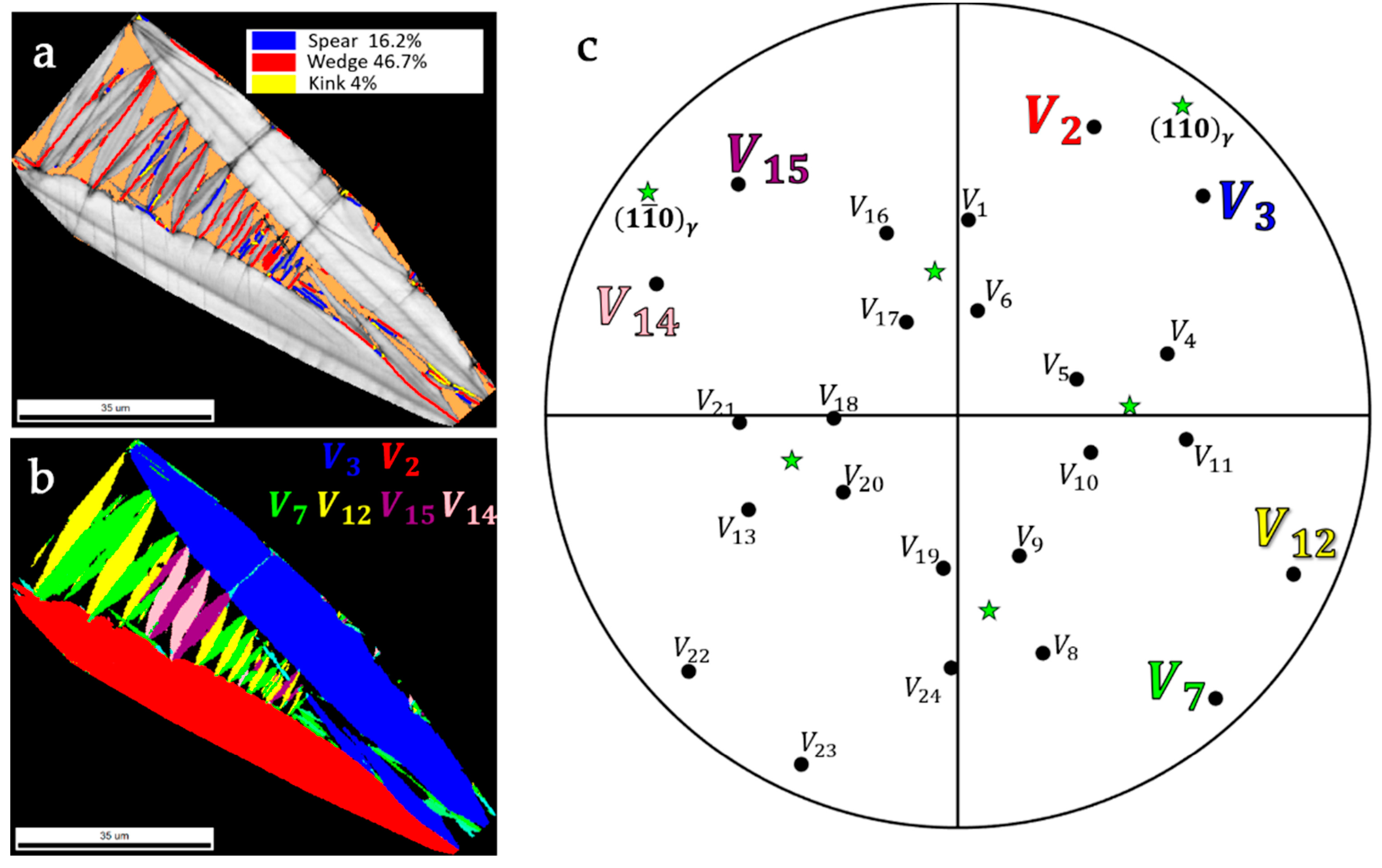
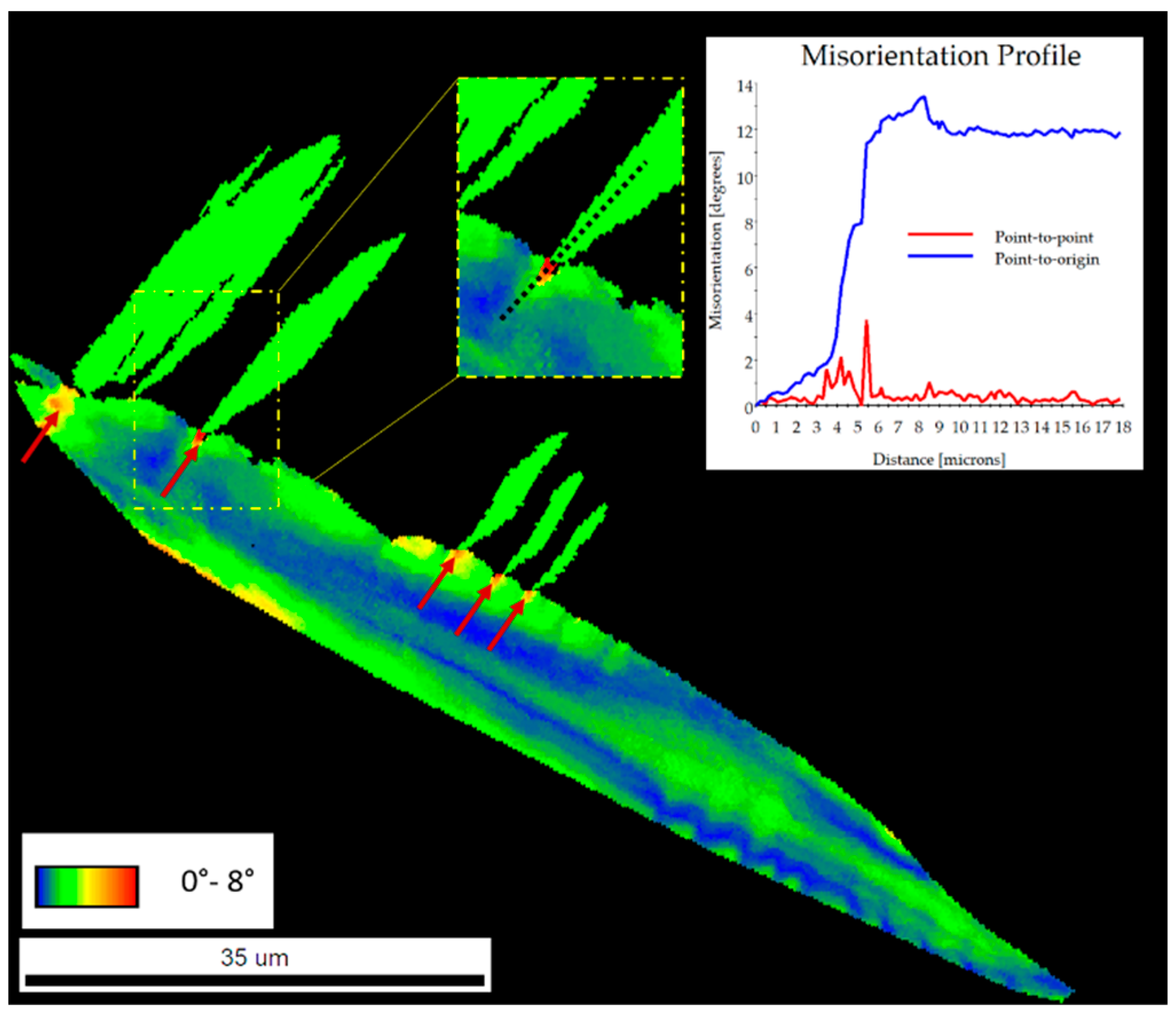
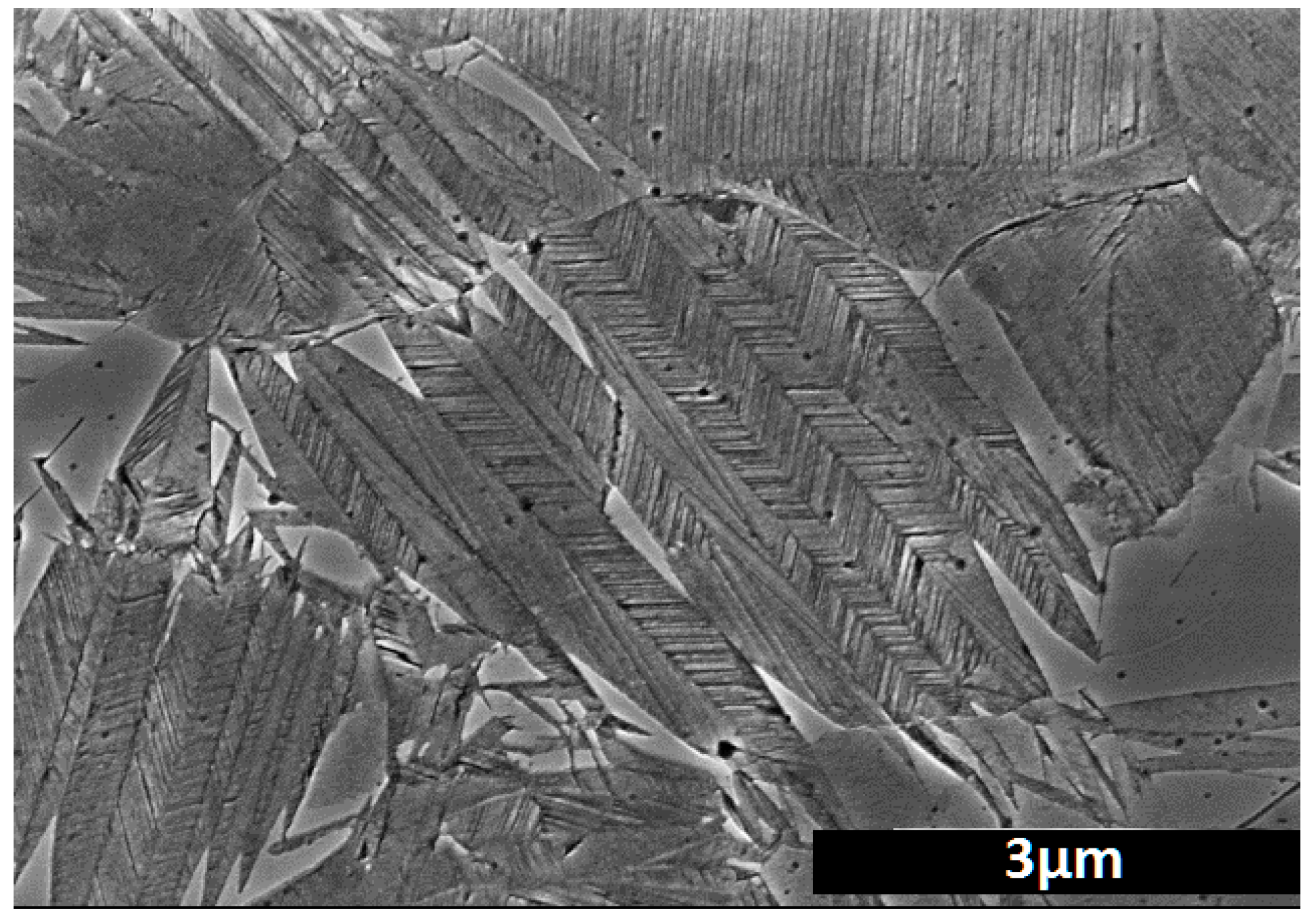
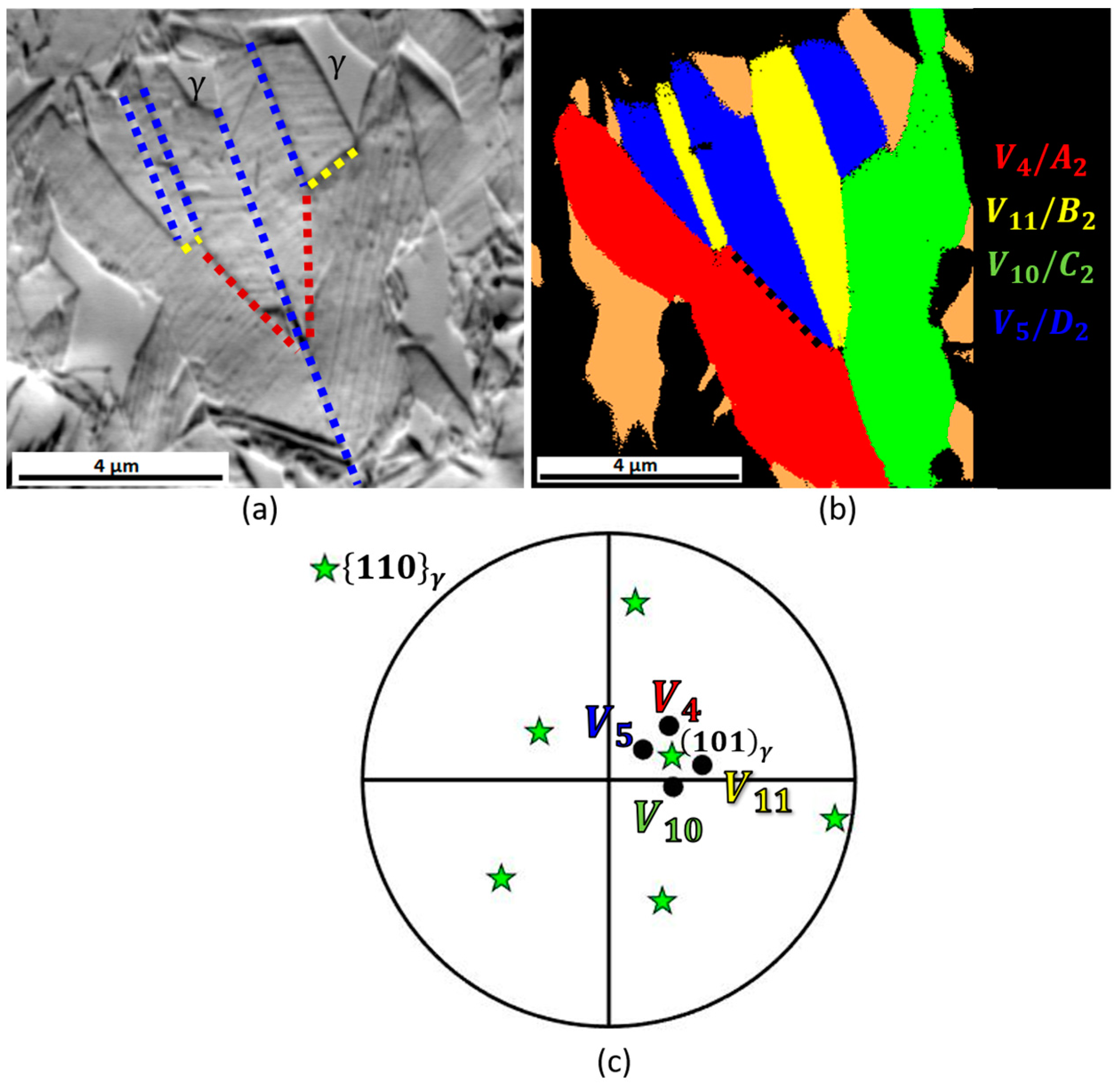




| Variant Pair, Solution Type | Coupling Factor | Angle between HP | Misorientation Angle/Axis | |
|---|---|---|---|---|
| Inter-generational couplings | /, (NS) | 0.98 | 77° | 12.6° <−0.17 −0.7 0.7> |
| /, (XI) | −0.88 | 88° | 53.1° <−0.73 0.65 0.22> | |
| /, (X) | 0.86 | 73° | 19.3° <0 −0.11 0.99> | |
| /, (XI) | −0.88 | 88° | 53.1° <0.22 0.73 0.65> | |
| /, (NS) | 0.98 | 77° | 12.6° <0.7 0.17 −0.7> | |
| /, (XI) | −0.88 | 88° | 53.1° <0.22 −0,73 −0.65> | |
| /, (XI) | −0.88 | 88° | 53.1° <0.73 0.65 −0.22> | |
| /, (X) | 0.86 | 73° | 19.3° <0.11 0 −0.99> | |
| Intra-generational couplings | /, (II) | −0.85 | 15° | 56.6° <0.71 0.71 0> |
| /, (III) | 0.88 | 21° | 15.2° <0.25 −0.68 0.68> | |
| /, (III) | 0.88 | 21° | 15.2° <−0.68 0.25 −0.68> | |
| /, (I) | −0.88 | 26° | 51.4° <−0.44 −0.63 0.63> | |
| /, (I) | −0.88 | 26° | 51.4° <0.44 0.63 0.63> | |
| /, (II) | −0.85 | 15° | 56.6° <−0.71 0.71 0> | |
| /, (II) | −0.85 | 15° | 56.6° <0.71 −0.71 0> |
| Solution Type | Variant Pairs | JP (in Austenite) | Deviation from Invariant Plane Condition (Angle/Axis) |
|---|---|---|---|
| I (Spear) | / / | 0.043° | |
| II (Wedge) | / / | 0.6° 0.6° | |
| III (Kink) | / / | 5.01° 5.01° |
Disclaimer/Publisher’s Note: The statements, opinions and data contained in all publications are solely those of the individual author(s) and contributor(s) and not of MDPI and/or the editor(s). MDPI and/or the editor(s) disclaim responsibility for any injury to people or property resulting from any ideas, methods, instructions or products referred to in the content. |
© 2024 by the authors. Licensee MDPI, Basel, Switzerland. This article is an open access article distributed under the terms and conditions of the Creative Commons Attribution (CC BY) license (https://creativecommons.org/licenses/by/4.0/).
Share and Cite
Malet, L.; Godet, S. Influence of Austenite Grain Size on the Variant Configurations of Martensite in a Fe-30.5Ni-0.155C Alloy. Crystals 2024, 14, 461. https://doi.org/10.3390/cryst14050461
Malet L, Godet S. Influence of Austenite Grain Size on the Variant Configurations of Martensite in a Fe-30.5Ni-0.155C Alloy. Crystals. 2024; 14(5):461. https://doi.org/10.3390/cryst14050461
Chicago/Turabian StyleMalet, Loïc, and Stéphane Godet. 2024. "Influence of Austenite Grain Size on the Variant Configurations of Martensite in a Fe-30.5Ni-0.155C Alloy" Crystals 14, no. 5: 461. https://doi.org/10.3390/cryst14050461




